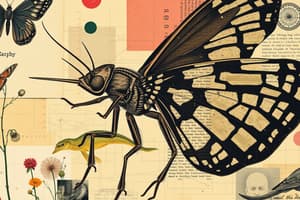Podcast
Questions and Answers
What is the main focus of taxonomy?
What is the main focus of taxonomy?
Which study uses heritable traits like morphology and DNA sequences to infer evolutionary history?
Which study uses heritable traits like morphology and DNA sequences to infer evolutionary history?
What is a phylogeny?
What is a phylogeny?
How does phylogenetics impact traditional classification?
How does phylogenetics impact traditional classification?
Signup and view all the answers
Which organisms are examples of taxonomic groups?
Which organisms are examples of taxonomic groups?
Signup and view all the answers
What do model organisms have in common?
What do model organisms have in common?
Signup and view all the answers
How can genetic evidence help reveal relatedness among organisms?
How can genetic evidence help reveal relatedness among organisms?
Signup and view all the answers
What is the primary basis of classic taxonomy classification?
What is the primary basis of classic taxonomy classification?
Signup and view all the answers
Which study focuses on creating phylogenetic trees?
Which study focuses on creating phylogenetic trees?
Signup and view all the answers
Study Notes
Identification and Classification of Organisms
- Organisms can be identified using classification guides, biological keys, DNA analysis, or protein analysis
- Two approaches to classification: taxonomy and phylogenetics
Taxonomy
- Involves identification and naming of organisms and their grouping based on shared characteristics
- Classic taxonomy classification is based on morphology
- Allows for familiarization with taxonomic groups, enabling predictions and inferences to be made between the biology of an organism and better-known (model) organisms
Phylogenetics
- Study of the evolutionary history and relationships among individuals or groups of organisms
- Uses heritable traits such as morphology, DNA sequences, and protein structure to make inferences about an organism's evolutionary history
- Creates a phylogeny (or phylogenetic tree), a diagrammatic hypothesis of an organism's relationships to other organisms
- Reveals relatedness obscured by divergent and convergent evolution
- Changing traditional classification of many organisms
Model Organisms
- Examples include the bacterium E. coli, the flowering plant Arabidopsis thaliana, and the nematode C. elegans
- Models are either easily studied or have been well-studied, allowing for predictions and inferences to be made about other organisms
Studying That Suits You
Use AI to generate personalized quizzes and flashcards to suit your learning preferences.
Description
Explore different methods for identifying organisms in a sample, including classification guides, biological keys, and DNA/protein analysis. Understand the differences between taxonomy, which focuses on naming and classifying organisms based on shared characteristics, and phylogenetics, which studies evolutionary history and relationships among organisms.




